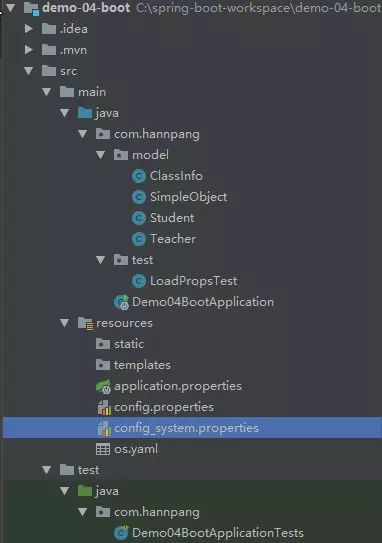- 1操作系统启动流程_计算机的启动流程在哪一章
- 2我的第一篇文章——stm32的ADC+DMA+滤波算法_32常用的滤波算法
- 3超超超简单的HarmonyOS入门应用——页面跳转——笔记(1)_鸿蒙 java跳转
- 4[Unity]怎么做个桌面宠物精灵desktop mascot_unity desktop mascot maker
- 5mysql mvcc 读写阻塞_全网最全一篇MySQL数据库MVCC详解,不全你打我
- 6【NeurIPS 2022】IPMT:用于小样本语义分割的中间原型挖掘Transformer_intermediate prototype mining transformer for few-
- 7Matlab证券回报率,MATLAB固定收益证券笔记
- 8Substring with Concatenation of All Words
- 9Linux的NAPI方法收包_netif_rx返回值
- 10Android Studio安卓手机模拟器环境搭建_android studio 模拟器
springboot修改配置文件属性值_SpringBoot注入数据的方式
赞
踩
做一个积极的人编码、改bug、提升自己
我有一个乐园,面向编程,春暖花开!

作者: 胖先森(来自:掘金)
原文链接:https://juejin.im/post/5c1f119ee51d4568f03b8857
关于注入数据说明

1.不通过配置文件注入数据
通过@Value将外部的值动态注入到Bean中,使用的情况有:
注入普通字符串
注入操作系统属性
注入表达式结果
注入其他Bean属性:注入Student对象的属性name
注入文件资源
注入URL资源
辅助代码
package com.hannpang.model;import org.springframework.beans.factory.annotation.Value;import org.springframework.stereotype.Component;@Component(value = "st")//对student进行实例化操作public class Student { @Value("悟空") private String name; public String getName() { return name; } public void setName(String name) { this.name = name; }}测试@Value的代码
package com.hannpang.model;import org.springframework.beans.factory.annotation.Value;import org.springframework.core.io.Resource;import org.springframework.stereotype.Component;@Componentpublic class SimpleObject { @Value("注入普通字符串") private String normal; //关于属性的KEY可以查看System类说明 @Value("#{systemProperties['java.version']}")//-->使用了SpEL表达式 private String systemPropertiesName; // 注入操作系统属性 @Value("#{T(java.lang.Math).random()*80}")//获取随机数 private double randomNumber; //注入表达式结果 @Value("#{1+2}") private double sum; //注入表达式结果 1+2的求和 @Value("classpath:os.yaml") private Resource resourceFile; // 注入文件资源 @Value("http://www.baidu.com") private Resource testUrl; // 注入URL资源 @Value("#{st.name}") private String studentName; //省略getter和setter方法 @Override public String toString() { return "SimpleObject{" + "normal='" + normal + ''' + ", systemPropertiesName='" + systemPropertiesName + ''' + ", randomNumber=" + randomNumber + ", sum=" + sum + ", resourceFile=" + resourceFile + ", testUrl=" + testUrl + ", studentName='" + studentName + ''' + '}'; }}Spring的测试代码
package com.hannpang;import com.hannpang.model.SimpleObject;import org.junit.Test;import org.junit.runner.RunWith;import org.springframework.beans.factory.annotation.Autowired;import org.springframework.boot.test.context.SpringBootTest;import org.springframework.test.context.junit4.SpringRunner;@RunWith(SpringRunner.class)@SpringBootTestpublic class Demo04BootApplicationTests { @Autowired private SimpleObject so; @Test public void contextLoads() { System.out.println(so); }}运行结果为:SimpleObject{normal='注入普通字符串', systemPropertiesName='1.8.0_172', randomNumber=56.631954541947266, sum=3.0, resourceFile=class path resource [os.yaml], testUrl=URL [http://www.baidu.com], studentName='悟空'}2.通过配置文件注入数据
通过@Value将外部配置文件的值动态注入到Bean中。配置文件主要有两类:
application.properties、application.yaml application.properties在spring boot启动时默认加载此文件
自定义属性文件。自定义属性文件通过@PropertySource加载。@PropertySource可以同时加载多个文件,也可以加载单个文件。如果相同第一个属性文件和第二属性文件存在相同key,则最后一个属性文件里的key启作用。加载文件的路径也可以配置变量,如下文的${anotherfile.configinject},此值定义在第一个属性文件config.properties
在application.properties中加入如下测试代码
app.name=一步教育在resources下面新建第一个属性文件
config.properties内容如下
book.name=西游记anotherfile.configinject=system在resources下面新建第二个属性文件
config_system.properties内容如下
我的目的是想system的值使用第一个属性文件中定义的值
book.name.author=吴承恩下面通过@Value(“${app.name}”)语法将属性文件的值注入bean属性值,详细代码见:
package com.hannpang.test;import org.springframework.beans.factory.annotation.Autowired;import org.springframework.beans.factory.annotation.Value;import org.springframework.context.annotation.PropertySource;import org.springframework.core.env.Environment;import org.springframework.stereotype.Component;@Component@PropertySource(value = {"classpath:config.properties","classpath:config_${anotherfile.configinject}.properties"})public class LoadPropsTest { @Value("${app.name}") private String appName; // 这里的值来自application.properties,spring boot启动时默认加载此文件 @Value("${book.name}") private String bookName; // 注入第一个配置外部文件属性 @Value("${book.name.author}") private String author; // 注入第二个配置外部文件属性 @Autowired private Environment env; // 注入环境变量对象,存储注入的属性值 //省略getter和setter方法 public void setAuthor(String author) { this.author = author; } @Override public String toString(){ StringBuilder sb = new StringBuilder(); sb.append("bookName=").append(bookName).append("") .append("author=").append(author).append("") .append("appName=").append(appName).append("") .append("env=").append(env).append("") // 从eniroment中获取属性值 .append("env=").append(env.getProperty("book.name.author")).append(""); return sb.toString(); }}测试代码
package com.hannpang;import com.hannpang.model.SimpleObject;import com.hannpang.test.LoadPropsTest;import org.junit.Test;import org.junit.runner.RunWith;import org.springframework.beans.factory.annotation.Autowired;import org.springframework.boot.test.context.SpringBootTest;import org.springframework.test.context.junit4.SpringRunner;@RunWith(SpringRunner.class)@SpringBootTestpublic class Demo04BootApplicationTests { @Autowired private LoadPropsTest lpt; @Test public void loadPropertiesTest() { System.out.println(lpt); }}运行结果为:bookName=西游记author=吴承恩appName=一步教育env=StandardEnvironment {activeProfiles=[], defaultProfiles=[default], propertySources=[ConfigurationPropertySourcesPropertySource {name='configurationProperties'}, MapPropertySource {name='Inlined Test Properties'}, MapPropertySource {name='systemProperties'}, OriginAwareSystemEnvironmentPropertySource {name='systemEnvironment'}, RandomValuePropertySource {name='random'}, OriginTrackedMapPropertySource {name='applicationConfig: [classpath:/application.properties]'}, ResourcePropertySource {name='class path resource [config_system.properties]'}, ResourcePropertySource {name='class path resource [config.properties]'}]}env=吴承恩3. #{...}和${...}的区别演示
A.${…}的用法
{}里面的内容必须符合SpEL表达式,通过@Value(“${app.name}”)可以获取属性文件中对应的值,但是如果属性文件中没有这个属性,则会报错。可以通过赋予默认值解决这个问题,如@Value("${app.name:胖先森}")
部分代码
// 如果属性文件没有app.name,则会报错// @Value("${app.name}")// private String name;// 使用app.name设置值,如果不存在则使用默认值@Value("${app.name:胖先森}")private String name;B.#{...}的用法
部分代码直接演示
// SpEL:调用字符串Hello World的concat方法@Value("#{'Hello World'.concat('!')}")private String helloWorld;// SpEL: 调用字符串的getBytes方法,然后调用length属性@Value("#{'Hello World'.bytes.length}")private String helloWorldbytes;C.#{...}和${...}混合使用
${...}和#{...}可以混合使用,如下文代码执行顺序:通过${server.name}从属性文件中获取值并进行替换,然后就变成了 执行SpEL表达式{‘server1,server2,server3’.split(‘,’)}。
// SpEL: 传入一个字符串,根据","切分后插入列表中, #{}和${}配置使用(注意单引号,注意不能反过来${}在外面,#{}在里面)@Value("#{'${server.name}'.split(',')}")private List servers;在上文中在#{}外面,${}在里面可以执行成功,那么反过来是否可以呢${}在外面,#{}在里面,如代码
// SpEL: 注意不能反过来${}在外面,#{}在里面,这个会执行失败@Value("${#{'HelloWorld'.concat('_')}}")private List<String> servers2;答案是不能。因为spring执行${}是时机要早于#{}。在本例中,Spring会尝试从属性中查找#{‘HelloWorld’.concat(‘_’)},那么肯定找到,由上文已知如果找不到,然后报错。所以${}在外面,#{}在里面是非法操作D.用法总结
#{…} 用于执行SpEl表达式,并将内容赋值给属性
${…} 主要用于加载外部属性文件中的值
#{…} 和${…} 可以混合使用,但是必须#{}外面,${}在里面
4.@Value获取值和@ConfigurationProperties获取值比较
| @ConfigurationProperties | @Value | |
|---|---|---|
| 功能 | 批量注入配置文件中的属性 | 一个个指定 |
| 松散绑定(松散语法) | 支持 | 不支持 |
| SpEL | 不支持 | 支持 |
| JSR303数据校验 | 支持 | 不支持 |
| 复杂类型封装 | 支持 | 不支持 |
配置文件yml还是properties他们都能获取到值;
如果说,我们只是在某个业务逻辑中需要获取一下配置文件中的某项值,使用@Value;
如果说,我们专门编写了一个javaBean来和配置文件进行映射,我们就直接使用@ConfigurationProperties;
关于数据校验的部分代码
@Component@ConfigurationProperties(prefix = "person")@Validatedpublic class Person { //lastName必须是邮箱格式 @Email private String lastName;5. @ImportResource引入配置文件
不推荐的使用方式
Spring Boot里面没有Spring的配置文件,我们自己编写的配置文件,也不能自动识别;
想让Spring的配置文件生效,加载进来;@ImportResource标注在一个配置类上
@ImportResource(locations = {"classpath:beans.xml"})导入Spring的配置文件让其生效编写配置文件信息
<?xml version="1.0" encoding="UTF-8"?><beans xmlns="http://www.springframework.org/schema/beans"xmlns:xsi="http://www.w3.org/2001/XMLSchema-instance"xsi:schemaLocation="http://www.springframework.org/schema/beans http://www.springframework.org/schema/beans/spring-beans.xsd"> <bean id="helloService" class="com.hanpang.springboot.service.HelloService">bean>beans>大概了解就好,我们基本上不使用这种方式
6.@Configuration注解
SpringBoot推荐给容器中添加组件的方式;推荐使用全注解的方式
1、配置类@Configuration作用于类上,相当于一个xml配置文件
2、使用@Bean给容器中添加组件,作用于方法上
/** * @Configuration:指明当前类是一个配置类;就是来替代之前的Spring配置文件 * * 在配置文件中用标签添加组件 * */@Configurationpublic class MyAppConfig { //将方法的返回值添加到容器中;容器中这个组件默认的id就是方法名 @Bean public HelloService helloService02(){ System.out.println("配置类@Bean给容器中添加组件了..."); return new HelloService(); }}使用Bean注入太麻烦,我们更加喜欢使用扫描的方式
import org.springframework.context.annotation.Bean;import org.springframework.context.annotation.ComponentScan;import org.springframework.context.annotation.Configuration;import com.wx.dao.IUserDao;import com.wx.dao.UserDaoImpl;//通过该注解来表明该类是一个Spring的配置,相当于一个传统的ApplicationContext.xml@Configuration//相当于配置文件里面的标签,扫描这些包下面的类的注解@ComponentScan(basePackages="com.hanpang.dao,com.hanpang.service")public class SpringConfig { // 通过该注解来表明是一个Bean对象,相当于xml中的 //bean的id值默认是方法名userDao /* @Bean public HelloService helloService02(){ System.out.println("配置类@Bean给容器中添加组件了..."); return new HelloService(); } */}附录
随机数
${random.value}、${random.int}、${random.long}${random.int(10)}、${random.int[1024,65536]}
往期精彩回顾
 Spring中@Autowired、@Resource和@Inject注解的使用和区别
Spring中@Autowired、@Resource和@Inject注解的使用和区别
掌握Spring常用注解【一】
一文学会Java死锁和CPU 100% 问题的排查技巧
【面试】MySQL 中NULL和空值的区别?
Mybatis 批量插入引发的血案
Java内存管理-Stackoverflow问答-Java是传值还是传引用?(十一)
你有遇到过MySQL因大小写敏感导致的问题吗
MySQL 的COUNT(x)性能怎么样?
共勉:作为一名程序员你应该怎么提一个高质量的问题?

 欢迎长按下图关注公众号
欢迎长按下图关注公众号

后台回复【资源】,获取珍藏干货!
99.9%的伙伴都很喜欢

朕已阅 


